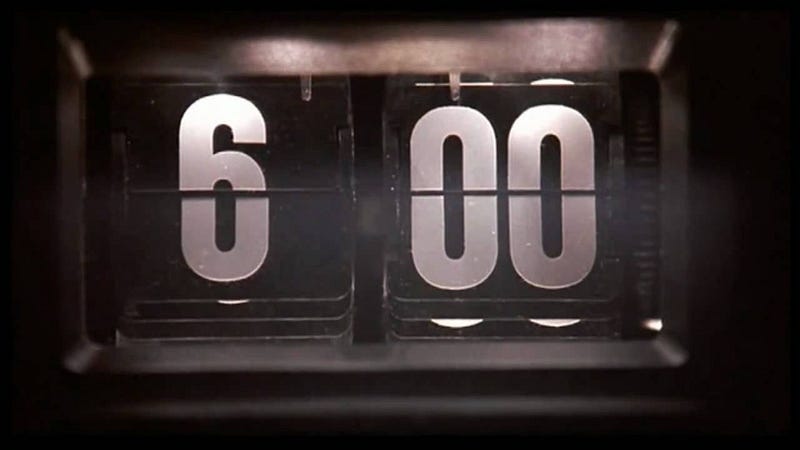
If you have not already read Jeff Bezos’ letter to shareholders, I highly recommend it. (The link is at the end of this post) What Bezos calls staying in Day 1 is the disruptive leadership mindset of a constant jump to the next S curve. This is a never-ending jump (hence the mild reference to Groundhog day in the opening image).
S-Curves
I wrote about S-Curves a couple of weeks back, but here is a quick reminder.
S curves are a great way to map both business and product lifecycles. S curves follow the shape of the letter S with a shallow start with early adopters and niche clientele. Rapid growth comes next, followed by a dominant position in the market.
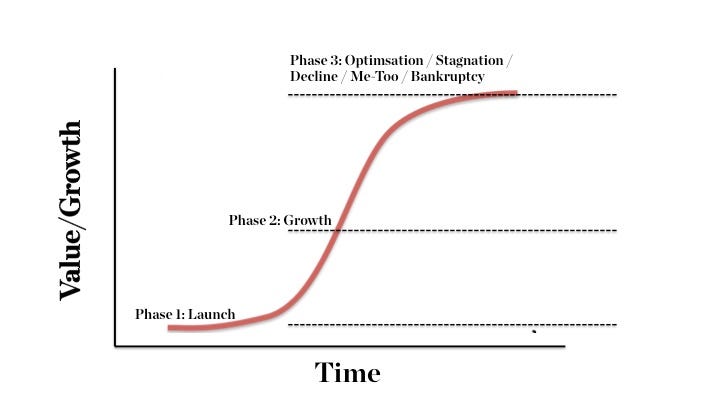
After the rapid growth, businesses or products plateau and experience stagnation, process optimization, automation, job cuts and quite often a “me-too” proposition.
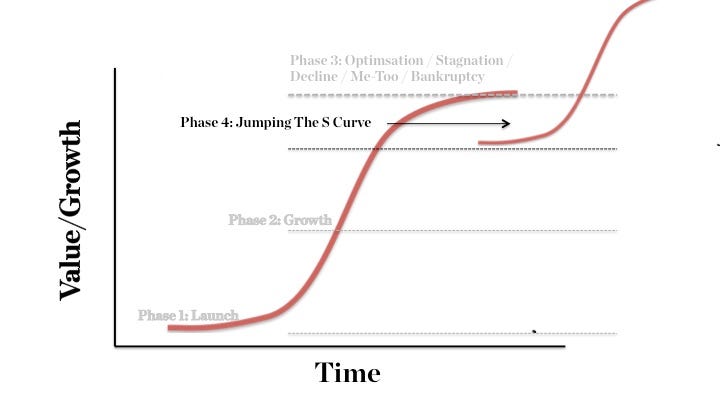
To Innovate Companies and Leaders need to jump from one S curve to another, but few have the courage to do so. The jump always looks like a step backwards, unless you have a leader who embraces the constant S curve mentality.
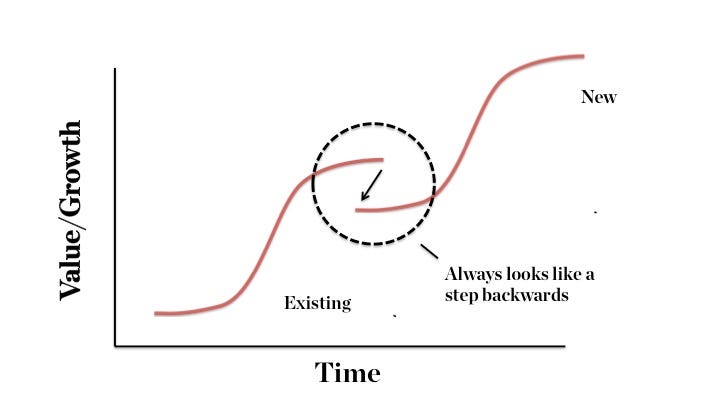
When Blockbuster CEO, Jim Keyes took over he ignored the next ideal jump for Blockbuster, which was a more ideal Blockbuster. When quizzed over why he turned down the option to acquire Netflix he stated: (for under 1 million) “Neither RedBox nor Netflix are even on the radar screen in terms of competition”. Not long after Blockbuster went bankrupt and we know the success story Netflix is today.
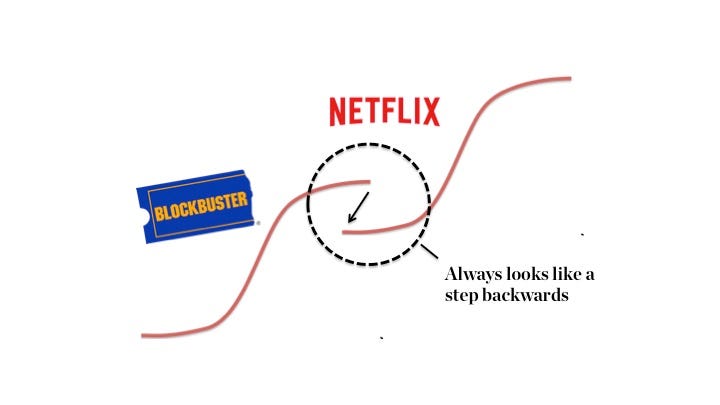
From Keyes perspective, he was doing a good job focusing on what Blockbuster did well today and felt looking at the next jump (which looks like a step back) was a distraction.
Staying in Day 1
“Staying in Day 1 requires you to experiment patiently, accept failures, plant seeds, protect saplings, and double down when you see customer delight. A customer-obsessed culture best creates the conditions where all of that can happen.” — Jeff Bezos
In the context of S curves Bezos is referring to adopting and maintaining the mindset of an S curve jump. More importantly, he is referring to the avoidance of the plateau stage, where companies usually reside for some time before eventual bankruptcy or acquisition by a more strategic company.
Bezos refers to the “top of the S” stage as Day 2. Here is how he describes Day 2:
“Day 2 is stasis. Followed by irrelevance. Followed by excruciating, painful decline. Followed by death.” — Jeff Bezos
“Top of the S”-dwelling companies are excellent at process, they are lean, they are efficient, alas this is often what kills them.
Bezos warns against this as follows:
“You stop looking at outcomes and just make sure you’re doing the process right. Gulp. It’s not that rare to hear a junior leader defend a bad outcome with something like, “Well, we followed the process.”
Process is important, yes, but being governed by process, not only chases off great employees, but also kills once-great companies.
This is exactly what we witnessed with Blockbuster. Unfortunately, this is what we are witnessing in so many companies today. Management resist rocking the boat and live in the short term, Leadership manage the short term, but don’t live in it.
Short term Thinking
Why would you invest time, risk and effort in the long-term strategy of the company when you can delight shareholders and boards of directors in making short-term gains and look like a hero? Bezos refers to delighting customers rather than shareholders, this involves investment that most financial departments will not ratify. (If you have had any issue with Amazon, the customer service is phenomenal).
So many corporate incentive systems are built around short term gains. If a CEOs bonus is structured on Ebita for example, why would she ever invest ahead of revenue? If the CFO is bonused in a similar manner, well then, you don’t stand a chance of growth. Regarding staff, why would you invest in training your staff? Why would you invest in your future strategy?
Instead, you would just exhaust the golden goose, keep farming the land without looking for pastures new and certainly without leaving it fallow. That means the CEO may make their quarterly targets, achieve their bonus, but the company will fail in the (not so) long run.
Disruptive leaders like Bezos hold a long term view. Bezos expressed his feelings on the topic of the long term as follows:
“We humans have become so technologically sophisticated that in certain ways we’re dangerous to ourselves. It’s going to be increasingly important over time for humanity to take a longer-term view of its future.” — Jeff Bezos.
Amazon: Thinking Long
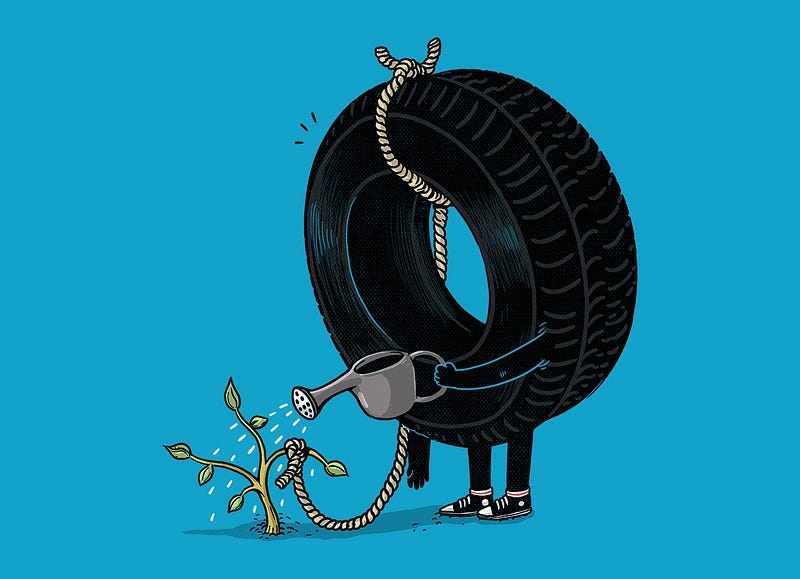
If you stand back and look at the amazing success that Amazon is, you have to admire the business leaders in Amazon. This started in Bezos’ garage and has grown into the behemoth that it is today. Bezos always had a long-term strategy and vision.
What is most admirable and smart about Bezos is that he has never stopped (re)investing in the long term, he has avoided the short term game of returning regular dividends to stockholders. Instead, he has focused on the future and with that, has insisted on groundhog day (regular) investment in that future.
Bezos knows that if he starts returning dividends that Amazon investors will become addicted to the returns. If this happens, a pressure to make premature decisions will come with it. When you think short, you make decisions based on short term returns.
Apart from the Amazon eco-system around e-commerce, think of the vision of the factory of the future, a fully automated factory run by drones and driven by data. Think of Amazon’s focus on the customer and their eye on a future logistics system. Think of Prime, which Bezos refers to in his letter:
“Even when they don’t yet know it, customers want something better, and your desire to delight customers will drive you to invent on their behalf. No customer ever asked Amazon to create the Prime membership program, but it sure turns out they wanted it, and I could give you many such examples.”
Amazon is currently building an “Uber/Hailo for trucking”, again with an eye on the long term (this is with an eye on driverless trucks of the future).
While most retailers are still grappling with e-commerce and digital transformation, Amazon is working in the future and waiting for the world to catch up. Bezos makes reference to this when he mentions machine learning and the fact that established companies struggle to be proactive with external trends.
Imagine if organisations, even adopted a fraction of future orientated strategies. Most are driven by short-term goals, short-term thinking, but also short-term focus.
We are amidst an era of hyper-rapid change and constant disruption, of the Fortune 500 firms ranging from 1955 to 2015 only 12% remain and we are going to see a lot more sink in the coming years.
Disruptive innovation and long-term thinking are the only way to ensure long term growth (unless you have a monopoly, but they too tumble in time.)
A final word from the man himself:
“To keep the energy and dynamism of Day 1, you have to somehow make high-quality, high-velocity decisions. Easy for startups and very challenging for large organizations. The senior team at Amazon is determined to keep our decision-making velocity high. Speed matters in business — plus a high-velocity decision making environment is more fun too.” — Jeff Bezos
Link to the full letter is here:
On this week’s innovation show, with a specialisation in leadership we talk to Dr. David Kahn. David found that most leadership content is great, but the delivery is geared towards academics, not frontline leaders. True to his growth mindset nature, he decided to do something about it and wrote “Cape, Spandex, Briefcase: Leadership Lessons from Superheroes” David is also Editor of the great blog Leadersayswhat.
On this week’s show we talk to David about the traits of true leaders, which can be drawn from superheroes. We also focus on how these skills can be applied to true innovation.
Robert Farrell is Director of the Digital Marketing academy and we talk Dark Social. Robert explains what it is, what the latest trends are and how chatbots and payments are entering the ecosystem at a rapid pace.
As always, the show is available below on the following platforms:
You can subscribe on iTunes here.
Website is here.
TuneIn is here.
Soundcloud and Google play are below.